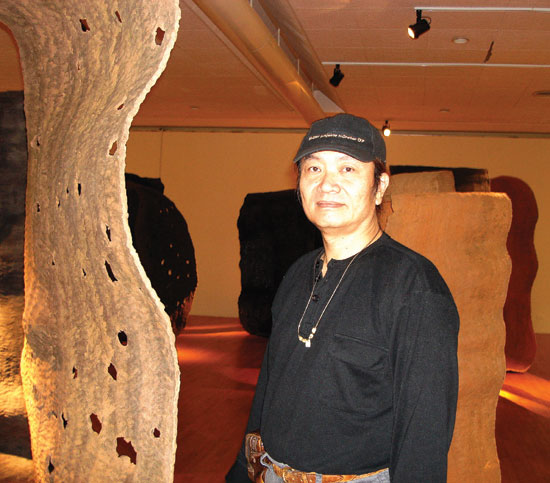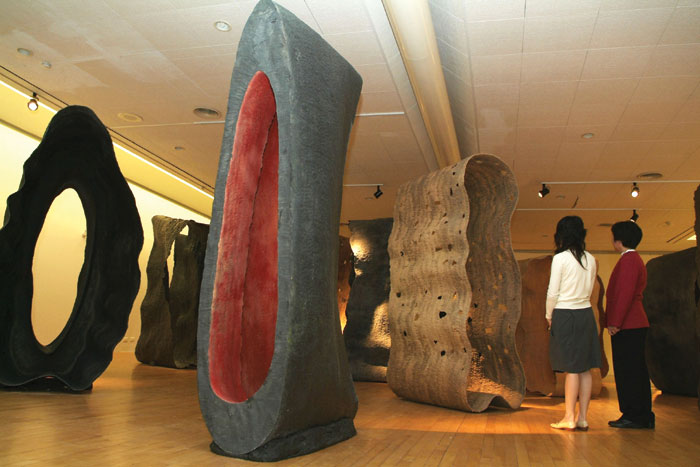Exploration and Innovative Self-expression Yung-Hsu Hsu's Theater of Clay / 自我極限的探索超越──徐永旭的「黏土劇場」
Exploration and Innovative Self-expression Yung-Hsu Hsu's Theater of Clay
◎Text by Fang-Ju Lin ◎Photos by Chung-Hui Pao and Jessica Lin 
It is a rare experience. Walking into galleries on the fourth floor of the Kaohsiung Museum of Fine Arts where the "Theater of Clay" is currently on exhibit, one will see gigantic two-meter high irregularly-shaped clay loops towering across the entire exhibition areas. These clay towers create a bewildering atmosphere for the viewers at first sight. When they walk closer by, these art pieces resemble kelp and look so light and delicate which conflicts with the usual clay work. These clay loops are so thin that the viewers are stunned by the dynamics and complexity of the work, but at the same time fear to damage the work by walking or even breathing too heavily next to them. Some viewers have even said this incredibly touching feeling gave them goose bumps.
"Theater of Clay" is the 2008 Exhibition featuring Yung-Hsu Hsu's work. There are two exhibition areas; one full of towering clay loops, and the other has a bridge composed of two large monitors and mirrors. These two exhibits use different materials, but the concept behind them is identical - Self-Observation and Communication.
The twenty exhibited clay loops are among the forty pieces that Yung-Hsu Hsu's created. Hsu mentioned that the biggest significance of this creation lies in the creation process. Over two and a half years, he spent thirteen to fourteen hours a day molding clay around tables into tall loops. The wall of the loops had to be as thin as possible, but also able to make the loops rise on their own and successfully fired and transferred. The process was full of anxiety, insecurity, exhaustion, and uncertainty. Unlike other people, Hsu does not stick with the elements that make a work successful. Instead, he neglects the factors that have benefited previous work and keeps himself in tension when working on a new piece. Through the tension and long-lasting work, he observes any potential impacts that may arise, and further understands and communicates with himself internally in order to achieve self-excess.
Every piece of work is an art creation from scratch. Artists use their fingers to shape the piece over and over again until the action becomes routine. To avoid being affected by the "inertia", Hsu used many different parts of his body to shape the clay, including the back of his hands, his arms, and even his cheeks. Seeing the surface of the clay, you will feel Hsu's efforts and strengths infused into the clay, which is extraordinarily moving.
Born in Kaohsiung City, Yung-Hsu Hsu's is an artist who engages himself in making large clay art works regularly. In recent years, he has worked in Taiwan, New York, Japan, South Korea, and Beijing. He taught in elementary schools for 22 years before being admitted to the Graduate Institute of Applied Arts at Tainan National University of the Arts. When he was young, Hsu was a sprinter and won many awards. He also played the zither and performed in several concerts. Due to illness, he had to stop playing the zither. That was when he began to devote himself to ceramics. Yung-Hsu Hsu's revealed that the entire "Theater of Clay" blueprint has not been fully carried out yet. As the next step, he will destroy the majority of the clay loops created, record the whole process and begin the next creation phase. Perhaps Hsu's creation is just like his life journey - full of continuous exploration and innovative self-expression. Let us look forward to his next art work!
自我極限的探索超越──徐永旭的「黏土劇場」
◎文/林昀熹 ◎攝影/鮑忠暉.林昀熹
很少有這樣的觀展經驗:走進高雄市立美術館四樓「黏土劇場」展廳,一件件超過兩公尺的巨型不規則陶圈,交錯地矗立在整個空間中,讓人一走進展場,就感受到進入迷宮般的撲朔迷離氛圍;進一步走近,海帶一般的造型使其看似柔軟輕盈,與認知中陶土作品的硬實兩相衝突,但它們又是那麼薄,薄到讓參觀者走過每一件作品旁時,一方面對於這些作品所展現的力度與難度感到驚嘆,一方面卻又小心翼翼,深怕腳步太重、甚至一個呼吸,就把作品給震倒、弄碎了,這種難以言喻的複雜感受,有些觀眾甚至說:「雞皮疙瘩都起來了!」
「黏土劇場」是藝術家徐永旭2008年的個展,展區分為兩個,一區佈滿巨型陶圈,另一區則是由兩面巨型螢幕與鏡面所組成的橋;二者雖然媒材完全不同,卻有著相同主題:對自我的觀看與對話。
展出現場的陶圈,是藝術家做了四十座之中的二十餘座。徐永旭表示,這次創作對他個人而言,最大的意義在於創作的過程;歷時兩年半、每天十三、十四小時的工作期間中,徐永旭不斷地將陶土圍著桌子捏塑,並且一圈一圈地疊高,要把陶土壁捏到最薄、卻又要能夠自然豎立,並且順利燒製、運送,過程中充滿了焦慮、不安、疲憊與未知,然而徐永旭與多數人相反,他在進行下一件作品時,並非保留安全完成的要素,而是將上一件作品成功的因素去除,持續精神緊繃的狀態,透過這種狀態與長時間的勞動,觀察這個創作的動作,會在自己身上產生怎樣的影響,並且在過程中,讓自己觀察自己,與自己對話,然後逾越自我。
而每一件作品,更是藝術家一點一滴捏塑而成,起先用手指,等到反覆的動作成為習慣之後,徐永旭為了不被「慣性」所役,改用手背捏陶,然後是手臂,甚至還曾以臉頰來捏塑作品。因此作品肌理上滿佈著徐永旭以全副身心與陶土相融的觸痕與力道,令人格外感動。
出生在高雄市的藝術家徐永旭,經常從事大型陶藝品的創作,近年則分別在台灣、紐約、日本、韓國、北京擔任駐地藝術家;在進入台南藝術大學應用藝術研究所深造之前,徐永旭曾擔任22年的小學老師,年輕時也曾是田徑選手,得過多次獎項,後來還投入古箏彈奏,開過幾次演奏會,然因病無法繼續,又改行從事陶藝至今。徐永旭表示,「黏土劇場」這個計劃其實尚未完全結束,接下來他要將大部分的陶圈破壞掉,記錄整個過程後,進入下一個創作階段。也許徐永旭的創作就像他的人生歷程,總是不斷地進行著自我極限的探索與超越,就讓我們期待他的下一個作品!